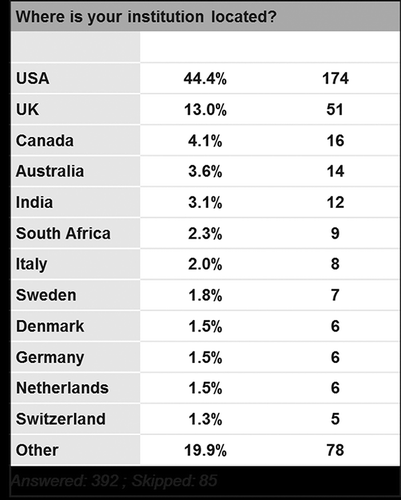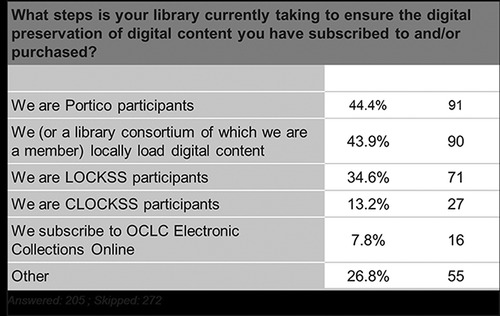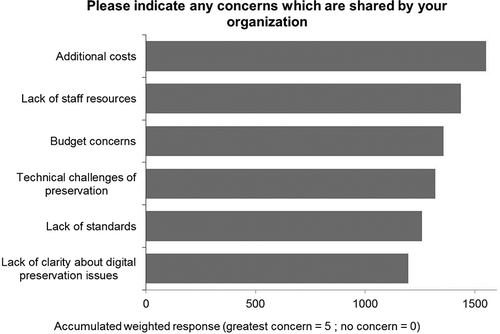Abstract
Colin Meddings of Oxford University Press presented the results of research conducted into opinions within the academic library community on digital preservation. In this context the term digital preservation refers specifically to the preservation of electronic scholarly literature with the goal of ensuring materials remain accessible to future scholars, researchers, and students. Oxford University Press intends this survey to build on and complement recent research done by the Association of Learned and Professional Society Publishers (ALPSP) into publisher strategies for preservation.
The results of a survey conducted by Oxford University Press were presented in this session. In the survey, librarians from around the world shared information on what their libraries are doing in regard to digital preservation, as well as opinions on digital preservation issues. Results point to a situation that is still evolving and highlight the need for continuing education on digital preservation issues.
When journals existed only in print, responsibility for preservation was reasonably straightforward. Publishers produced journals and librarians purchased them in print and preserved them. The advent of online journals and the resulting changes in the journals supply chain has made this division of responsibility less clear. Journal content is increasingly licensed in electronic format, sometimes via intermediaries and sometimes with no print equivalent. With more and more scholarly content born digital, a print archive is sometimes no longer a viable preservation option. Digital preservation is sometimes a function of libraries, sometimes of publishers, a combination of the two, or done by a third party on behalf of both.
Oxford Journals has participated in a wide range of digital preservation initiatives for a number of years, including making agreements with the Koninklijke Bibliotheek and Portico, and participating in Lots of Copies Keep Stuff Safe (LOCKSS). In 2008 the Association of Learned and Society Publishers (ALPSP) published a report on publisher preservation strategies that prompted us to reexamine our activities in this area.Footnote 1 While looking into our internal processes and strategy there was one obvious but unanswered question: Does our strategy align with the expectations of our library customers? In the process of answering this question we saw an opportunity to build on the earlier ALPSP research and explore library attitudes towards and participation in current long-term digital preservation initiatives.
So it was that early in 2010 we undertook an online survey of librarians which was generously answered by 475 individuals. The purpose of the survey was to assess the participation levels of libraries in existing initiatives and their attitudes toward the various options available. We also asked some questions on the problems they face with digital preservation, including funding issues. The survey was posted on library e-mail discussion lists and distributed by e-mail to our own internal database of library contacts.
Respondents represented a wide geographic spread, with North American (49.7 percent) and European (30.9 percent) institutions particularly well represented (see ). We would have liked a greater response from Asia (13.5 percent), and South America was underrepresented. By far the top country was the United States with 174 respondents representing 44.4 percent of the total. This was followed by the United Kingdom, Canada, Australia, and India. Various European countries had a handful of respondents each, and there was a fairly long tail with fifty-five countries represented in total among the respondents. Academic libraries made up the largest sector of respondents (67 percent) with smaller numbers of medical (9.7 percent), corporate (2.6 percent), and government (8.2 percent) libraries responding. Most of the academic libraries serve both undergraduate and post-graduate communities (55.1 percent of total respondents).
The first question we asked directly relating to preservation was “How important is the issue of digital preservation to your library?” Eighty-five percent of respondents stated that the issue of digital preservation is either important or very important to their library. This corresponds to a similarly high percentage of publishers (91 percent) when asked the same question in the previous ALPSP survey. Aware of the potential for self-selection bias among our audience, we further asked, “Have staff members or faculty members from your organization ever approached you to enquire about electronic journal preservation?” Seventy-seven percent of respondents had been approached at least once, suggesting a possibility that bias did exist, but still a significant majority of respondents indicated they were concerned about digital preservation.
In contrast to the high levels of concern, less than half of respondents (46.1 percent) stated that they were currently taking steps to ensure the long-term preservation of digital content. A similar percentage (46.9 percent) stated that they were not taking any steps at the current time with a small number (6.9 percent) answering “don't know.” Digging into the survey a little deeper reveals that this initially alarming statistic may not be so clear cut. Some respondents held differing assumptions about what constitutes digital preservation, and other respondents clearly held differing views about what counted as participation in an initiative.
We tried to be clear that in the context of our survey, long-term digital preservation referred to ensuring the preservation of electronic scholarly literature with the specific goal of ensuring that materials remain accessible to future scholars, researchers, and students, and not to the issue of post-cancellation access. If this was clear in our own minds, then this did not appear to be the case among the survey respondents. Looking at many of the free-text answers in detail shows that some respondents were confusing print and digital preservation as well as confusing longer-term preservation with post-cancellation access. The last of these is perhaps understandable given that some of the major initiatives mentioned in this survey offer provisions for both circumstances.
Despite these difficulties, some clear trends did emerge. We asked those who stated that they were participating in an initiative to identify what they were doing. Initiatives supported by respondents correspond with those that Oxford Journals supports, with Portico leading the way (44.4 percent), followed by LOCKSS (34.6 percent) and Controlled LOCKSS (CLOCKSS) (13.2 percent) (see ). One of the surprising results for us was the high number of institutions locally loading digital content (44 percent).
We asked those who said they were not participating in programs to choose from a selection of statements explaining why this was the case. Forty-three percent stated that they rely on publishers to undertake preservation, and a similarly large proportion of 41 percent cited cost concerns as a reason why they are not taking action. Some libraries stated that preservation was not a core issue for them (12 percent) or that they are happy that external programs would deliver adequate benefits (15 percent), reminding us that not every institution considers digital preservation to be an important part of their mission. We also asked those not currently participating in any program if they intend to in the future. One hundred fifteen respondents (57.5 percent) stated that they have no plans to participate in any program in the future.
The next set of questions within the survey focused on possible concerns that librarians may have about digital preservation. The purpose of these questions was to try and understand why libraries may not be participating in initiatives, or why they favor some more than others. Not surprisingly given the current economic and funding climate it was the cost and resource implications of digital preservation that came out as of most concern. Additional costs associated with preservation were followed by lack of staff resources as the biggest concerns (see ). Interestingly, concerns around technical challenges and a lack of standards were not as high up on the list as they had been for publishers in the ALPSP publisher survey.
When asked who should take responsibility for long-term preservation, there was a clear preference for joint library and publisher initiatives over either publisher-led initiatives or library-led initiatives. There was a notable desire to see national libraries take on a greater role. The answers to this question also showed that there was an acceptance that independent not-for-profit organizations could play a role, but that there is a distinct lack of enthusiasm for any for-profit initiatives.
We also attempted to tease out some opinions on the more difficult question of who should fund digital preservation initiatives. The question asked respondents to choose between library funding, publisher funding, or joint funding of digital preservation. Within this we acknowledged that publishers were unlikely to fund initiatives without passing some of these costs on to their customers. It was joint publisher–library funding that came out as the most preferred option, but only by a small margin over the other two options. This perhaps reflects the greater confusion or uncertainty when it comes to funding of digital preservation.
The outcome of the survey has not changed Oxford University Press' overall policy of supporting multiple digital preservation initiatives. In fact it has reinforced our resolve to maintain this approach, at least in the foreseeable future while the picture remains an uncertain and evolving one. What the survey has done is reassure us that those initiatives that we do already support are also those most favored and supported by our customers. It has also made us realize that more education and advocacy are required on this topic in order to help our customers, and the wider scholarly community, understand the importance of digital preservation and the complexities in choosing a solution. We hope that in sharing the results of this survey, we may have gone some small way to achieving that goal.
Notes
1. Sarah Durrant, Long-Term Preservation: Results from a Survey Investigating Preservation Strategies amongst ALPSP Publisher Members (n.p.: Association of Learned and Professional Society Publishers, 2008), http://www.alpsp.org/ForceDownload.asp?id=882 (accessed November 22, 2010).


